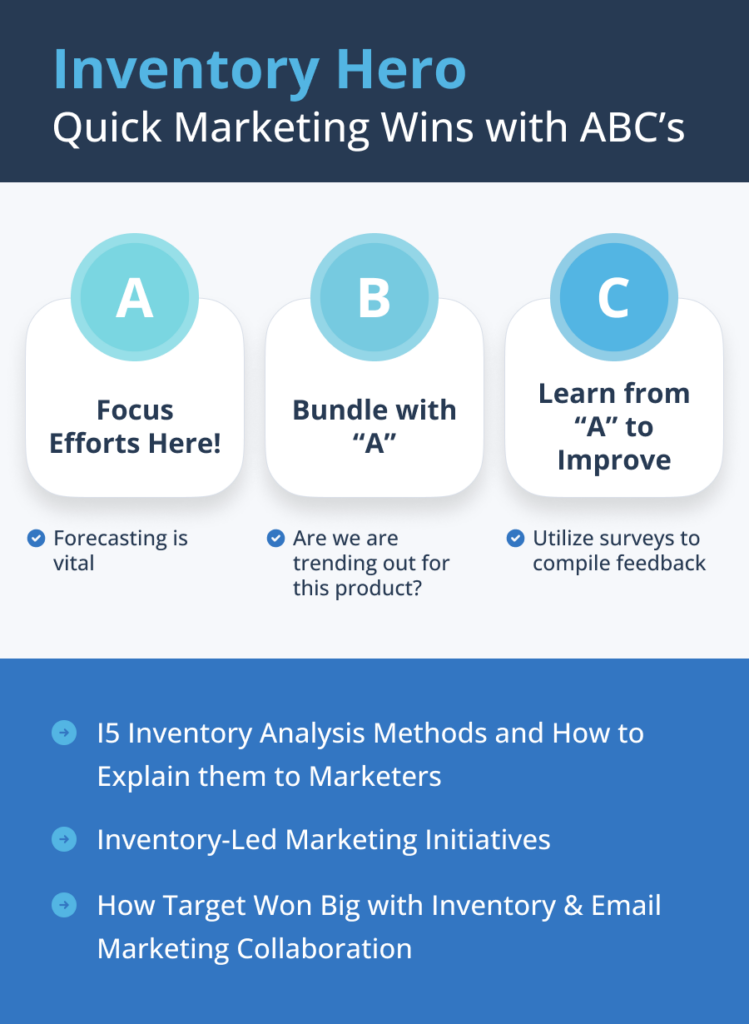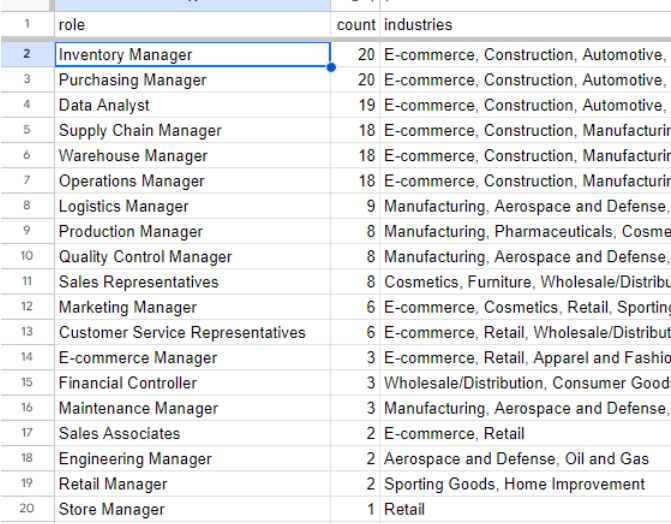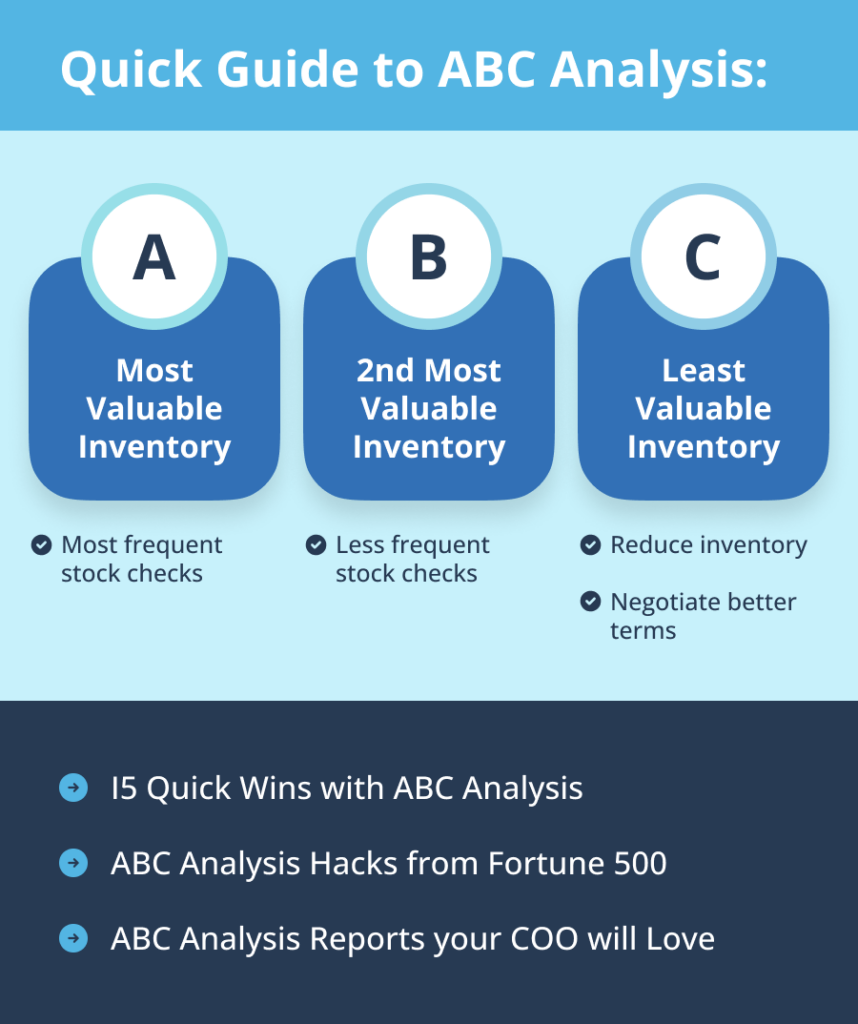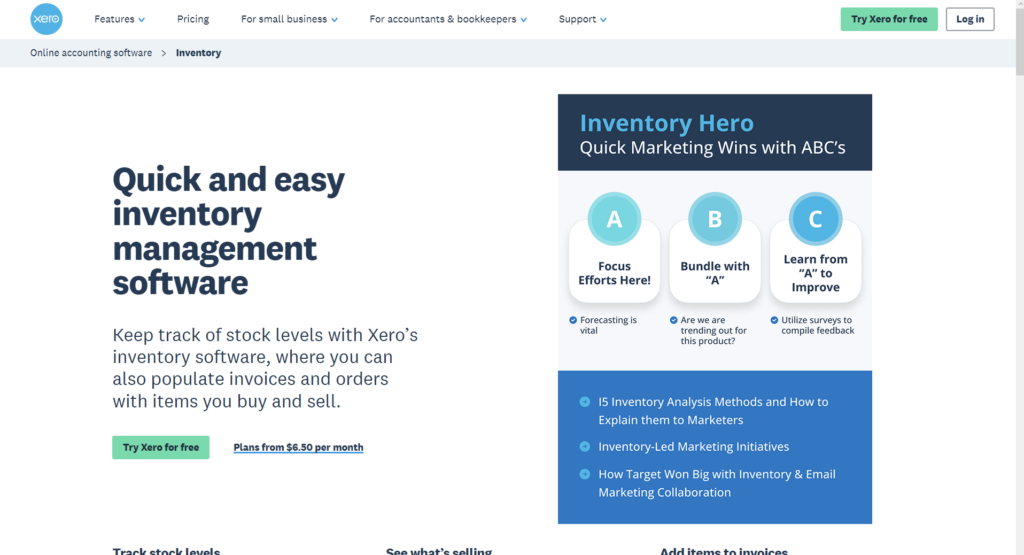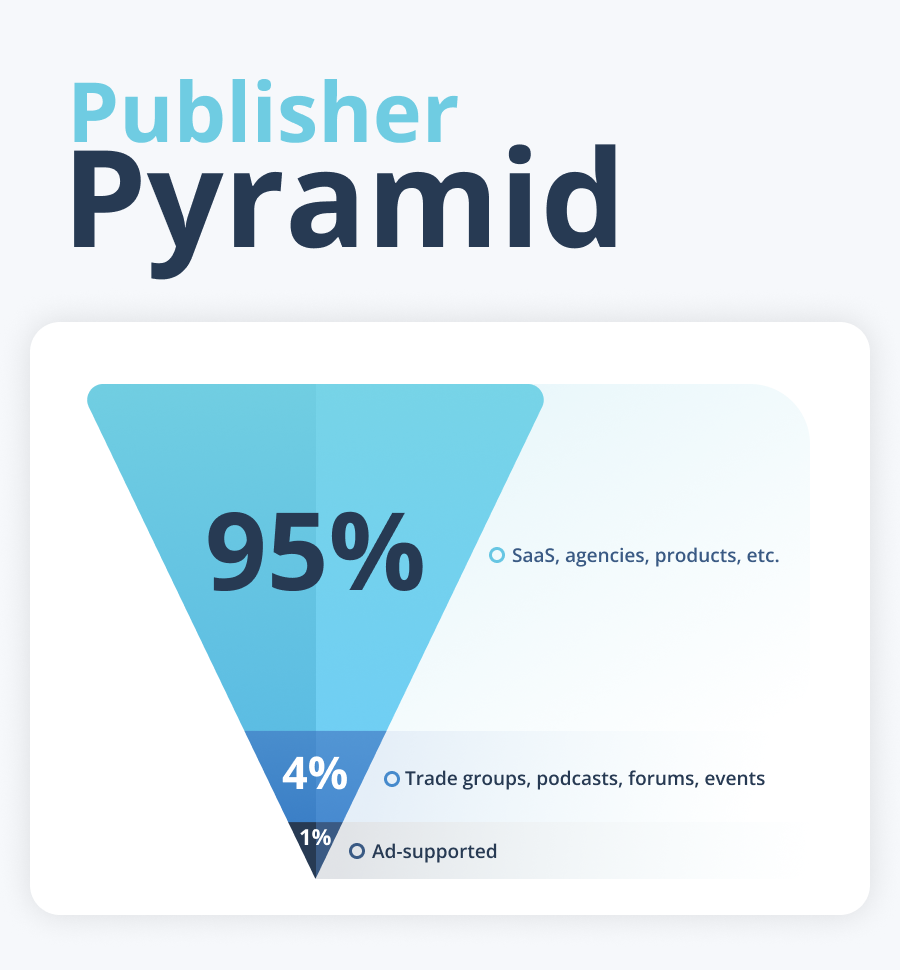Here’s a guide to applying ChatGPT in the development of a link campaign for this inventory management software page from Xero.
In this guide we’ll use ChatGPT to brainstorm:
- Primary industries using [inventory management software] (note – to follow along with your own page, insert your offering here…)
- Key users/beneficiaries of inventory management software within those industries
- What managerial roles your users and beneficiaries report UP to
- What information and guidance the managerial roles need from your software’s users
- The array of “existential” concerns your users have in regards to their job performance (essentially, topics)
We then use the ChatGPT outputs to determine:
- Most important industries for your offering
- Most frequently-occurring roles
- Most reachable roles (that is, roles who are targeted by the highest volume of unique publishers)
- Topics for reaching those roles with content and earning links back to the page that sells inventory software
We use these roles, key concerns and our reachability metrics to guide our creation of Citable Elements – the short snippets of on-page content that super-charge sales page link building campaigns.
Here’s an example of a citable element from this exercise:
Let’s dive in!
ChatGPT Prompts for Generating the Stakeholders of the Offering’s Benefit
- Input, read URL [in ChatGPT 4.5 – video on how-to from Alan Silvestri] and describe the offering that’s for sale on the page
- List the top 20 industries, ordered by size, that use inventory management software, comma separated with no description
- List the top 10 roles in [industry] that benefit from inventory management software, comma separated with no description
- List the top 5 roles within the organization who [role] reports to, comma separated with no description (generates the role’s key stakeholders)
This will produce an enormous amount of industries, roles and reported-to roles to then prioritize. We suggest you begin your prioritization by counting the frequency of occurrence of the primary user/beneficiary roles… example in the next section.
>> Role Occurrence Counting
- Sort roles by frequency of occurrence within the industry (consider weighting the industry size too, but not for this particular exercise…)
- Sort role-reports by frequency of occurrence
- Retain the relationships of role, industry and role-reports for future sorting and filtering
It’s important here to recognize that we’re counting the frequency of role occurrence within an LLM’s index. If you have access to someone familiar with your industry, this is a great time to run your initial assessment past them and ask questions like:
What industries or roles are missing?
What’s over or understated in terms of importance?
When can we talk again about this, as I’ll have more questions further on in my research?
One issue as you loop in other internal experts – be sure they understand that you’re identifying audiences for link building, not audiences for selling more units to.
Here’s our count, with only one of the “single industry” or “long tail” roles represented there at row 20:
Your next task with your expert-checked and frequency-sorted data set will be plugging in volume-estimates from Google.
>> Publisher Volume Estimates Methods:
- Result count for: [role] inurl:blog for [industry]
- Additionally, you could look for blogs and publications that are industry-centric. There will be hundreds of e-commerce-facing publishers out there whose audiences would appreciate the inventory management topic area.
- As an addition/alternative to result count you could do a count of the top 10 publisher types (Direct Competitor Offering | Non Competitor Offering | Advertising Supported) for the suggested query
- Average the result count for Roles with multiple instances across the industries (multiple industries will result in more potential trade and ally-vendor-publishers)
- Do the same for role-manager accessibility in the event that they prove more-frequently addressed by publishers and/or they’re frequently reported-to by users of your other offerings.
- For example, are there fewer publishers for the role of inventory managers and more for the role of COO? Then figure out how to position content for the COO publishers.
Many SEOs may wonder why we’d look at result count. If you’re unfamiliar, that’s the number of results that Google says exists within its index. It’s probably the least reliable number Google provides. That said, we’re looking for lightning-quick assessment here, and it’s a decent stand-in for estimating the volume of unique publishers writing for a particular audience.
If you wanted to add in a layer of hand-check, look at each of the above queries and rummage the top 20 results for competing/non-competing SaaS companies, trade publications, trade organizations, forums, and/or news sites that target the role you’re investigating.
Since we saw “inventory manager” mentioned so frequently (20 times in 20 industries) it seemed like a strong starting point. Here’s what the SERP looks like for [inventory management blog] though so it looks like we’ll be weeding through competitors and other SaaS providers (this is expected):
Let’s assume we wanted to come up with some great topics to pitch to these publishers (or our editorial team for that matter…). Here are some prompts for digging into areas of intersect between Inventory Managers, their bosses and inventory management software.
>> Prompts for Learning the Existential Threats (Topics of Interest) for Inventory Managers
- Please list 20 role-specific mistakes that inventory managers could make that would result in their termination
- Note – this may not lead to citable element concepts but it will help you with a fuller and more detailed understanding of their challenges
- What day-to-day tasks does inventory management software speed up or enable for inventory managers?
- List the 10 biggest challenges faced by inventory managers and how they can overcome them using insights from inventory management software
- List 5 questions that [role] may need to answer when reporting to [manager]
- Note in this prompt we’re looking for potential variations in reporting required by the various perspectives of the managers.
- list five actions an inventory manager could discover are required based on inventory management software along with who they need to convince about taking the action
- Who do inventory managers report to, and what outcomes are they responsible for
- List 5 skills needed by inventory managers that are non-technical
- What makes inventory management software valuable to the [role]’s manager?
- What methods of analysis should an inventory manager use on the data from inventory management software, and for each method, which of their managers cares the most and what are 3 actions they may recognize are required?
- This last one proved the most valuable, overall in that it provides deep, utility-based connectivity to other roles. Further, describing or discussing analytic methods should be of paramount importance to this particular vendor.
So now, how can you tell which response from ChatGPT will be “the one” that enables an entire link building campaign? At the start of the exercise we didn’t know, but the answer is “the last one in the list above.”
Why?
It enables us to generate citable element concepts that speak to all of the following:
- An Audience of Inventory Managers
- An Audience of Roles who Manage Inventory Managers
- The Available Publishers’ Content Needs
- Our Organization’s Capacity for Contributing Unique Expertise
Here are some samples of the output to the question: “What methods of analysis should an inventory manager use on the data from inventory management software”:
Each one of these scenarios can and should be its own lengthy blog post, with graphics, guidance, interviews, videos, case studies, etc. Any longform content should not live on the actual sales page, but certainly an “ABC Analysis Quick Start” graphic could live there, along with links to deeper, fuller explanation.
For example:
This ABC Analysis graphic (minus the “learn more” section) could serve as an image to add to your offsite content placement campaigns. And you’d cite this stub, or citable element, on the sales page when linking to your source.
If you wanted to expand your reach even further, you’d need to consider adding more citable elements to your page that focus on explaining and acting on inventory management concepts to different stakeholders. Here are some of the outputs further in. If you could find publishers who write for Finance Managers within businesses, you’d want to add a section on “Gross Margin Return on Investment” analysis.
If your publisher analysis showed that there were more sales strategy-oriented publishers available then perhaps you’d want to focus more on Demand Forecasting:
For both you could create an image that conveys the concept at the highest-possible level along with links to deeper coverage of the topic. The image itself – and the collected resources – make for excellent citable elements for use in a money page link building campaign.
>> Designing Topic Pitches for the Available Publishers
For the purpose of a full-blown campaign outline, we’d like to focus on the relationship between the Inventory Manager’s insights on stock and the Marketing Manager.
Why? To make it easier on the outreach side. There are 1000s of times more publishers focused on marketing topics and we’ll have lots more opportunities for reaching audiences and building links with our brand’s expertise. And we don’t have an actual client pushing back on our choice – it probably would make sense, from a “nearness to value” perspective, to target the roles in descending order. Besides, according to our link gap analysis the page at Xero needs 389 more linking domains to get seriously competitive in the SERPs for their primary keywords.
We’ll stick with the ABC Inventory Analysis concept but look at how the Inventory Manager would communicate their analysis to the Marketing Manager (they are in row 12 in the Role Occurrence Count section above).
Here’s what AI predicts will be useful:
First we’ll redesign our citable element from above. It needs to focus on benefits the Inventory Manager can bring to marketing campaigns via ABC analysis.
Notice the all-new focus on communications and collaboration between Inventory and Marketing departments. Each of the titles would need to link to their respective documents on the blog, or their proper location within the site architecture. The image itself could be utilized as a “hero image” on earned placements and cite this particular learning section stub probably at the bottom of the Inventory Management sales page.
Topic ideation would depend on the audience for the publisher. You’d want to pitch email-oriented guides and articles to email marketing agencies and SaaS tools for example. And definitely look for ways to utilize or compliment their offerings. You’d do the same for Paid Search tools and agencies – pitching topics about methods of enhancing the efficiency of ad spend with insights from the inventory team. Even reaching out with topics on terminology overlap from Inventory to Marketing could be very useful. Getting on the same page can be difficult!
With title concepts in hand you can begin pitching your publishers.
Here’s our representation of what you can and should expect in terms of how publishers make their living, and why they’re publishing on the web:
This is why in our efforts we focus primarily on the 95% of publishers.
Don’t ignore the 5% top-tier folks, not at all, but if you intend to show impact for your link building efforts, you’ll need to close as much of your link gap as possible.
We hope this article helps you on that journey.
Resources for Further Exploration
AI can transform how you design link campaigns, especially for niche offerings. Here are some resources to help you get started:
- Link Launch Tool: Try the beta version for free to organize and execute link-building campaigns tailored to your software offerings. Try it here.
- Explore More: Dive into additional strategies and insights from our blog to refine your AI-driven link-building approach. Explore here.
